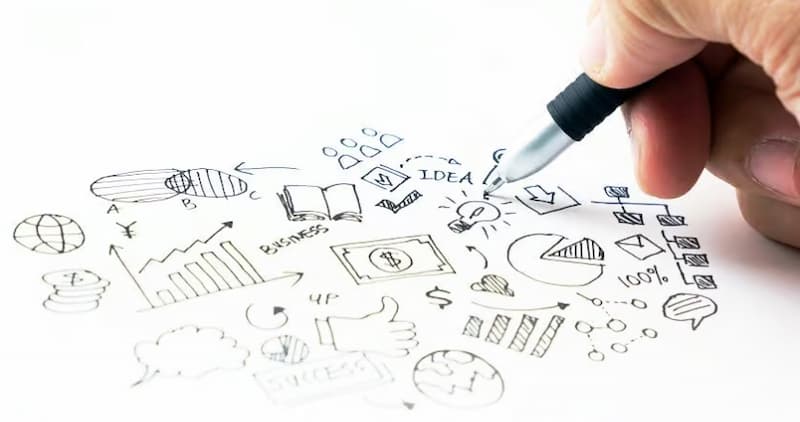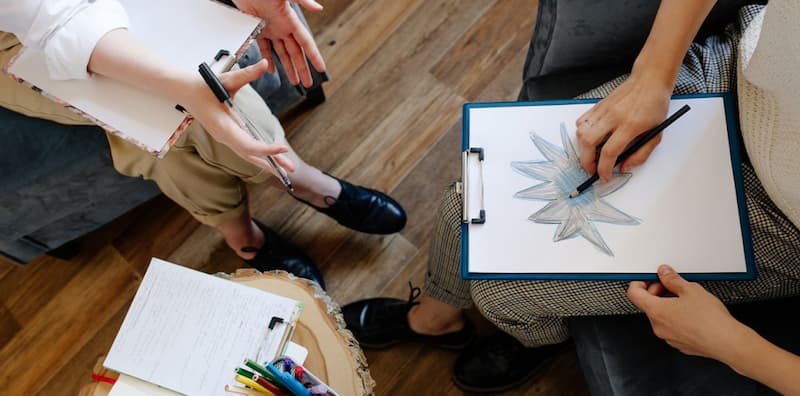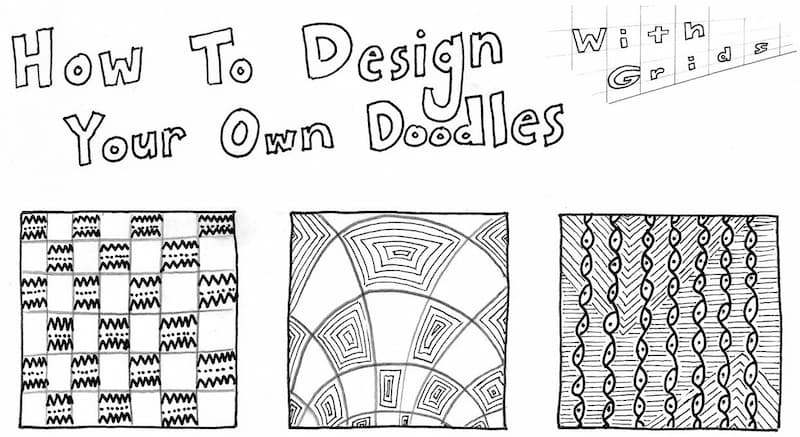
8 May, 2024
Exploring Doodle Art and Zentangle Patterns in Art Therapy
Let's look at a world where art isn't just about creating beautiful pieces, but also about finding peace and relaxation. Yes, I'm talking about the delightful realm of doodle art and Zentangle patterns used in art therapy. So, grab your favourite pen, get comfy, and let's embark on this journey of self-expression and healing through simple lines and patterns.
The Underrated Art of Doodling

Doodling is often seen as what you do when you're not paying full attention. Maybe you've found yourself scribbling away during a long lecture or while chatting on the phone. But here's the thing: doodling is not just about making random marks on a page; it's a creative process that can have some pretty cool benefits.
A Brain Booster
Believe it or not, it can actually help your brain in several ways. First off, it's great for focus and concentration. When you doodle, you engage your brain just enough to keep it from daydreaming, but not so much that you can't pay attention to other things. It's like a mini-exercise for your brain that helps you stay present and engaged.
Stress Relief and Relaxation
There's something incredibly calming about the repetitive motion of it. It's almost meditative. As you let your pen or pencil flow freely on the paper, creating swirls, lines, or whatever shapes you fancy, your mind begins to relax. This can be a great stress reliever, especially after a long day or during tense situations.
Unlocking Creativity
It can be a gateway to greater creativity. It's a form of expression that doesn't have rules or boundaries. You can let your imagination run wild, and sometimes, this is where the best ideas pop up. Doodles can evolve into elaborate drawings, character designs, or even inspire artistic projects.
Improving Memory and Comprehension
There’s some pretty neat research out there that suggests it can help with memory retention. When you doodle while listening to something, you’re engaging different parts of your brain, which can help you remember information better. So, the next time you're doodling during a meeting or lecture, know that you're actually helping your brain hold onto those details.
It's for Everyone
The best part? Anyone can do it. You don't need fancy art supplies or any particular skill. It's an inclusive, universal form of expression. Whether you're drawing stick figures, abstract shapes, or just random lines, you're part of the club.
In Summary: Celebrate Your Doodles!
So, let's give a round of applause for doodling – the unsung hero of the art world. It's a simple yet powerful tool that helps us focus, relax, and unleash our creativity. The next time you catch yourself doodling, smile and let your pen keep going. You're not just scribbling; you're engaging in a joyful, therapeutic, and creative activity that's good for your brain and soul.
Zentangle Patterns: A Step Further

Zentangle is a relatively new art form, and it's all about creating structured, repetitive patterns. Think of it as a blend of art and meditation. The name might sound a bit sophisticated, but the concept is wonderfully simple. You start with a basic outline and then fill it with patterns, creating a beautiful mosaic of shapes and designs.
The Zen in Zentangle
There's a reason why "Zen" is part of the name. Zentangle art is incredibly calming. It encourages a state of mindfulness and relaxation, where you focus on the process of drawing simple line patterns. This focus can help quiet the mind, a bit like a meditative practice, which is great for reducing stress and anxiety.
The Joy of Patterns
It is all about patterns, and the possibilities are endless. From swirls and dots to lines and curves, you can mix and match to create unique artworks. And the beauty of it is that you don't have to be an experienced artist to start. The patterns are straightforward and achievable for anyone, regardless of artistic skill.
No Mistakes, Only Discoveries
One of the most liberating things is that there are no mistakes. Every line contributes to the overall design, even if it wasn't what you initially intended. This approach is fantastic for building confidence in your creative abilities and for learning to embrace imperfections.
Great for Focus and Creativity
It can also sharpen your focus and boost creativity. The process of creating patterns requires a certain level of concentration, which can help improve your attention span. And as you get more comfortable with different patterns, you might find yourself coming up with new, creative ways to fill your designs.
How to Get Started
Getting into it is easy. You just need a piece of paper and a pen. Nothing fancy. Just a standard ballpoint pen is fine. Start with a simple shape or border and begin filling it with patterns. There's no right or wrong way to do it – just let your creativity flow. You can find plenty of pattern ideas online or come up with your own.
In Summary: The Artful Escape
Zentangle art is more than just drawing patterns; it's a form of artistic meditation that offers a peaceful escape from the hustle and bustle of daily life. It's a gentle reminder that sometimes, the simplest activities can bring the most joy and relaxation.
Why Pen Art in Therapy?

First off, there's something to be said about the simplicity of pen and paper. Unlike other art forms that might require a whole bunch of supplies, you only need a basic pen and some paper. This simplicity is key. It makes art therapy accessible to virtually anyone, anywhere. No need for a fancy studio or expensive materials. Whether you're at home, in a therapist's office, or even taking a break at work, you can dive into pen art therapy.
The Comfort of Familiarity
Most of us have used a pen and paper at some point in our lives, so there's a certain comfort and familiarity there. It's not intimidating, unlike, say, facing a blank canvas with a paintbrush. This familiarity can make it easier to get started, especially for those who might feel anxious about trying something new or "artistic."
A Space for Expression
Pen art creates a safe, private space for expressing thoughts and emotions. Sometimes it's hard to put feelings into words, but letting them flow through the pen can be incredibly therapeutic. It's a way to visually externalise what's inside, which can be a powerful step in understanding and managing emotions.
The Mind-Hand Connection
There's something almost meditative about the physical act of drawing or writing. The movement of the hand can help to focus the mind, bringing a sense of calm and mindfulness. This connection can be particularly beneficial for people who find it hard to meditate in more traditional ways. As the pen moves across the paper, it can help to quieten mental chatter and bring a sense of peace.
Versatility and Creativity
It can take many forms, from structured activities like Zentangle or specific therapeutic exercises to freeform doodling or drawing. This versatility means that it can be tailored to individual needs and preferences, making it a flexible tool in therapy. Plus, it's a way to explore creativity, which can be empowering and confidence-boosting.
In Summary: The Power of Simplicity
So, why pen art in therapy? Because sometimes, the simplest tools can be the most powerful. A pen and paper offer an accessible, familiar, and flexible way to express ourselves and find a sense of calm. It's a reminder that you don't need much to embark on a journey of self-discovery and healing.
The Therapeutic Power of Pen Art

Think about the last time you found yourself mindlessly doodling. There's a certain rhythm to it, right? The way the pen glides across the paper, creating loops, lines, and shapes, can be incredibly soothing. This rhythmic motion is almost like a dance of the hand - it's meditative and calming. It helps to slow down our racing thoughts, bringing a sense of peace and tranquility, much like a quiet meditation session.
Reducing Anxiety and Stress
In our fast-paced world, stress and anxiety can creep up on us all too easily. This is where pen art steps in as a superhero! Focusing on simple lines and patterns is a way to anchor our minds in the present moment, away from anxious thoughts about the past or future. It's a form of mindfulness, really - being fully engaged in the here and now, with each stroke of the pen helping to ease the mind.
Sharpening the Mind: Boosting Focus and Concentration
Did you know that engaging in pen art can also help sharpen your mind? It's true! Working on a piece of pen art requires a level of concentration that can actually train your brain to focus better. It's a gentle yet effective way to improve mental clarity and attention span. So, the next time you're working on a detailed doodle or a Zentangle pattern, remember you're also giving your brain a nice little workout.
Expressing the Inexpressible
Sometimes, words just aren't enough to express how we feel. This is where pen art becomes a powerful tool for self-expression. It offers a non-verbal way to express emotions, thoughts, and feelings. You might start a doodle feeling one way and find that your mood has shifted by the time you finish. It's a subtle yet profound way to explore and understand your emotions, and often, you might discover feelings you didn't even know you had!
Creating Your Own Doodle and Zentangle Art

Jumping into the world of doodle and Zentangle art is like opening a door to endless creativity and relaxation. Whether you’re an experienced artist or a total newbie, these forms of art are wonderfully inclusive and therapeutic. Let's break down each step a bit more to help you get started on this enjoyable journey.
1. Just Start: The Beauty of Spontaneity
- Freedom in Simplicity: The first step is the simplest yet often the hardest - just start. Grab any pen you have, find a piece of paper, and put down a line, a dot, a swirl, or whatever shape comes to mind. There's no need for a plan or an end goal.
Letting Go: This is about letting your hand and your subconscious take the lead. You might be surprised at the shapes and designs that emerge when you give yourself the freedom to create without a filter.
2. Build Patterns: Structuring Your Creativity
Zentangle Basics: If you're leaning towards Zentangle art, begin with a basic shape. It could be a square, a circle, or any closed form. This shape, often called a 'tile' in Zentangle terminology, will be your canvas.
- Filling the Space: Within this shape, start creating repetitive patterns. These could be anything from lines, curves, dots, to more complex shapes. The key is repetition and simplicity. The patterns should be easy enough to draw repeatedly but engaging enough to keep your interest.
Inspiration and Guides: There are numerous Zentangle patterns available online for inspiration. Beginners can follow these patterns until they feel comfortable enough to create their own.
3. Embrace Imperfections: Celebrating the Unique
- Perfectly Imperfect: Your doodles and Zentangles are unique to you, including what you might see as 'mistakes.' These imperfections add character and style to your work.
- Growth and Learning: Each one is a step in your creative journey. Embrace each line, even if it's not what you initially intended. It's all part of the learning and growing process as an artist.
4. Use it as a Meditation Tool: Finding Mindfulness
- Daily Practice: Set aside a few minutes each day for your art. This consistent practice can become a form of meditation, helping you to relax and find mindfulness.
- Creating a Calm Space: Find a quiet spot where you won't be disturbed. This time is just for you and your art. As you draw, focus on your breath and the movement of your pen. Let the rhythmic motion calm your mind.
- Reflect and Absorb: After each session, spend a moment to look at your creation and reflect on the experience. Notice how you feel – often, you'll find that you're more relaxed and centred than when you started.
Creating your own doodle and Zentangle art is a wonderful way to explore your creativity, reduce stress, and find a moment of peace in your busy day. Remember, there's no pressure to create a masterpiece. It's all about the process, your personal expression, and the joy of creation. So, grab that pen and let the journey begin!
Sharing and Reflecting
One of the joys is sharing your creations with others or reflecting on them by yourself. It can be a wonderful way to gain insights into your emotional state or simply to appreciate the beauty you can create with just a pen.
Conclusion: The Artistic Path to Mindfulness
Doodle art and Zentangle patterns in art therapy are all about enjoying the journey, not just the destination. It's amazing how a simple pen can become a powerful tool for mindfulness, relaxation, and self-discovery. So, the next time you find yourself doodling during a phone call or meeting, remember that you're not just passing time; you're engaging in a therapeutic and creative process.
Happy doodling and tangling, everyone! Let your pen be your guide to a more peaceful and creative state of mind. Remember, in the world of pen art therapy, every line, curve, and pattern is a step towards inner calm and creativity.
The Pens Only Team

